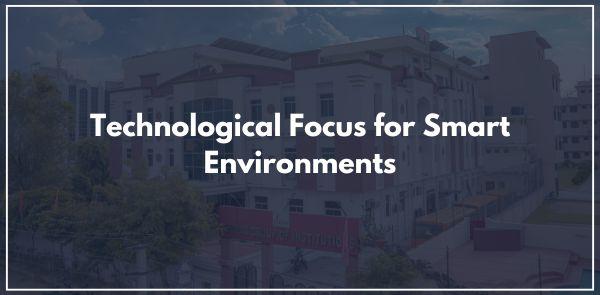
In the era of digital transformation, the concept of "smart environments" has emerged as a key driving force in reshaping how people live, work, and interact with their surroundings. Smart environments, powered by the Internet of Things (IoT), artificial intelligence (AI), and advanced data analytics, offer unprecedented opportunities to create more efficient, sustainable, and responsive spaces. These environments—ranging from homes and offices to cities—are designed to enhance human experience, optimize resource use, and streamline operational processes. This article explores the technological focus driving smart environments and their potential to transform various sectors.
1. The Foundation: IoT and Connectivity
The backbone of any smart environment is connectivity. The Internet of Things (IoT) plays a central role by connecting physical objects and devices to the internet, allowing them to collect and exchange data. These devices—ranging from thermostats and light bulbs to security cameras and industrial machinery—are embedded with sensors, actuators, and processors that enable them to communicate and respond to changes in the environment.
In a smart home, for instance, IoT-enabled devices can monitor energy consumption, adjust temperature settings, and even detect security breaches. In a smart city, IoT sensors deployed on infrastructure such as roads, bridges, and buildings can collect real-time data on traffic patterns, weather conditions, and air quality. This wealth of information can be analyzed to improve urban planning, optimize traffic flow, and reduce energy usage, ultimately contributing to a more sustainable environment.
2. Artificial Intelligence and Machine Learning
While IoT provides the data, artificial intelligence (AI) and machine learning (ML) are responsible for making sense of that data. By analyzing vast amounts of information, AI systems can learn from patterns and predict future events, enabling smart environments to become more intuitive and responsive.
In smart homes, AI-powered assistants like Amazon's Alexa or Google Assistant can learn user preferences and behaviors, offering personalized experiences such as adjusting lighting based on time of day or playing music suited to a user’s mood. Machine learning algorithms can also optimize energy consumption, adjusting heating and cooling based on occupancy patterns to minimize waste.
In smart cities, AI and ML can be used for predictive maintenance, helping detect and address infrastructure issues before they become major problems. For instance, AI systems can monitor the health of pipelines and bridges, predicting wear and tear and suggesting maintenance schedules. Additionally, AI can optimize traffic signals based on real-time traffic data, improving the flow of vehicles and reducing congestion.
3. Data Analytics and Big Data
The integration of smart devices into everyday life generates vast amounts of data, and this is where big data analytics comes into play. The ability to capture, store, and analyze large datasets in real-time is crucial for deriving actionable insights from the data generated by smart environments.
Data analytics which is taught in various management and computer application programs of Poddar International College, Jaipur can provide valuable insights into user behavior, helping businesses and governments improve services and offerings. For instance, retailers can analyze shopping patterns to offer personalized product recommendations, while urban planners can use data from smart city sensors to make informed decisions about public transportation and infrastructure investments.
In the context of smart buildings, data analytics can optimize the use of space and resources. Sensors can track foot traffic in offices, providing insights into which areas are used most often. With this data, companies can optimize workspace layouts and make informed decisions about energy management, helping to create more efficient and comfortable work environments.
4. Automation and Robotics
Another key technological focus in smart environments is automation. Automation is transforming industries by enhancing efficiency and reducing the need for manual intervention. In smart environments, this translates into systems that can automatically adjust settings, manage tasks, and even perform physical actions.
In smart homes, automation allows devices to respond to certain triggers. For example, when a homeowner leaves the house, motion sensors can detect this and automatically switch off lights, adjust the thermostat, and activate security systems. Similarly, robotic vacuum cleaners can autonomously clean homes, reducing the need for human involvement in mundane tasks.
In smart factories, robotics is also playing a significant role in automating production lines and improving precision. Automated systems are capable of adjusting production schedules based on real-time demand, reducing waste, and enhancing the overall efficiency of manufacturing processes.
5. Edge Computing and Low-Latency Systems
With the increasing number of connected devices and the need for real-time processing, edge computing has become an essential component of smart environments. Edge computing involves processing data closer to where it is generated, rather than relying on distant cloud servers. This helps to reduce latency and ensures faster decision-making, which is crucial for applications like autonomous vehicles and real-time monitoring of critical infrastructure.
For example, in a smart city, edge computing can enable real-time monitoring of traffic conditions, allowing traffic signals to adjust instantly based on traffic flow. In healthcare, edge devices can monitor patients’ vital signs and alert medical professionals if immediate intervention is required.
By bringing computation closer to the source of data, edge computing also reduces bandwidth usage and enhances the overall efficiency of smart environments, ensuring that systems can operate seamlessly even in areas with limited internet connectivity.
6. Sustainability and Green Technologies
Sustainability is a critical focus of modern smart environments. With growing concerns about climate change and resource depletion, smart technologies are being leveraged to create more environmentally friendly spaces.
Smart buildings, for instance, are equipped with energy-efficient systems that monitor energy consumption and optimize the use of resources. Smart thermostats, lighting, and heating systems can adjust based on occupancy, reducing waste and saving energy. In smart cities, the use of IoT sensors can help monitor air quality, water usage, and waste management, enabling cities to operate in a more sustainable and efficient manner.
Furthermore, renewable energy sources such as solar and wind power are being integrated into smart grids, allowing for decentralized energy production and consumption. This reduces reliance on fossil fuels and promotes the use of clean energy, contributing to a greener, more sustainable future.
Poddar International College, a leading educational institution in Jaipur, applies sustainability measures and green technologies in a practical learning approach. The students will benefit greatly from a very effective exposure program, which will open doors for them to many opportunities and develop them in every aspect to contribute to their environmental-protective careers soon.
Conclusion
Smart environments are the future of how we live, work, and interact with our surroundings. At the core of these environments lies a combination of cutting-edge technologies such as IoT, AI, machine learning, big data analytics, automation, and edge computing. These technologies work together to create spaces that are not only more efficient and sustainable but also more responsive and personalized to the needs of users.
As these technologies continue to evolve, smart environments will become increasingly integrated into our daily lives, offering new opportunities for innovation, sustainability, and enhanced human experience. The focus on sustainability, energy efficiency, and data-driven insights ensures that the future of smart environments will be both intelligent and environmentally conscious. With these advancements, we can expect smarter cities, more comfortable homes, and more efficient workplaces that improve the quality of life for all.

